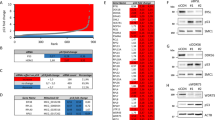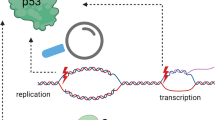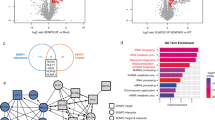Abstract
The dynamic processes of cell growth and cell division remain under constant surveillance. As one of the primary ‘gatekeepers’ of the cell, p53 has a major role in sensing a variety of stressors to maintain cellular homeostasis. Growth is driven by new protein synthesis, a process that requires robust manufacture of ribosomes in the nucleolus. Ribosome biogenesis is a complex process comprising transcription, modification, and processing of ribosomal RNA, production of ribosomal proteins (RPs) and auxiliary factors, and coordinated assembly of ribonucleoprotein particles to produce mature ribosomes. As the major function of the nucleolus, ribosome biogenesis demands a considerable amount of resources and must be maintained in a coordinated manner to ensure fidelity of the process. Perturbations to many aspects of ribosome biogenesis are thought to contribute to ‘nucleolar stress’ and trigger a RP-Mdm2-p53 stress response pathway. In this review, we will clarify how disruption to three major components of ribosome biogenesis can trigger nucleolar stress and activate p53, thereby lending support to a RP-Mdm2-p53 ribosome biogenesis surveillance pathway.
This is a preview of subscription content, access via your institution
Access options
Subscribe to this journal
Receive 50 print issues and online access
$259.00 per year
only $5.18 per issue
Buy this article
- Purchase on Springer Link
- Instant access to full article PDF
Prices may be subject to local taxes which are calculated during checkout


Similar content being viewed by others
References
Amsterdam A, Sadler KC, Lai K, Farrington S, Bronson RT, Lees JA et al (2004). Many ribosomal protein genes are cancer genes in zebrafish. PLoS Biol 2: E139.
Anderson SJ, Lauritsen JP, Hartman MG, Foushee AM, Lefebvre JM, Shinton SA et al. (2007). Ablation of ribosomal protein L22 selectively impairs alphabeta T cell development by activation of a p53-dependent checkpoint. Immunity 26: 759–772.
Ayrault O, Andrique L, Fauvin D, Eymin B, Gazzeri S, Seite P . (2006). Human tumor suppressor p14ARF negatively regulates rRNA transcription and inhibits UBF1 transcription factor phosphorylation. Oncogene 25: 7577–7586.
Azuma M, Toyama R, Laver E, Dawid IB . (2006). Perturbation of rRNA synthesis in the bap28 mutation leads to apoptosis mediated by p53 in the zebrafish central nervous system. J Biol Chem 281: 13309–13316.
Barkic M, Crnomarkovic S, Grabusic K, Bogetic I, Panic L, Tamarut S et al. (2009). The p53 tumor suppressor causes congenital malformations in Rpl24-deficient mice and promotes their survival. Mol Cell Biol 29: 2489–2504.
Berghmans S, Murphey RD, Wienholds E, Neuberg D, Kutok JL, Fletcher CD et al. (2005). tp53 Mutant zebrafish develop malignant peripheral nerve sheath tumors. Proc Natl Acad Sci USA 102: 407–412.
Bertwistle D, Sugimoto M, Sherr CJ . (2004). Physical and functional interactions of the Arf tumor suppressor protein with nucleophosmin/B23. Mol Cell Biol 24: 985–996.
Bhat KP, Itahana K, Jin A, Zhang Y . (2004). Essential role of ribosomal protein L11 in mediating growth inhibition-induced p53 activation. EMBO J 23: 2402–2412.
Blattner C, Hay T, Meek DW, Lane DP . (2002). Hypophosphorylation of Mdm2 augments p53 stability. Mol Cell Biol 22: 6170–6182.
Boisvert F-M, van Koningsbruggen S, Navascues J, Lamond AI . (2007). The multifunctional nucleolus. Nat Rev Mol Cell Biol 8: 574–585.
Budde A, Grummt I . (1999). p53 Represses ribosomal gene transcription. Oncogene 18: 1119–1124.
Cairns CA, White RJ . (1998). p53 Is a general repressor of RNA polymerase III transcription. EMBO J 17: 3112–3123.
Chakraborty A, Uechi T, Higa S, Torihara H, Kenmochi N . (2009). Loss of ribosomal protein L11 affects zebrafish embryonic development through a p53-dependent apoptotic response. PLoS One 4: e4152.
Chen D, Zhang Z, Li M, Wang W, Li Y, Rayburn ER et al. (2007). Ribosomal protein S7 as a novel modulator of p53-MDM2 interaction: binding to MDM2, stabilization of p53 protein, and activation of p53 function. Oncogene 26: 5029–5037.
Chesnokov I, Chu WM, Botchan MR, Schmid CW . (1996). p53 Inhibits RNA polymerase III-directed transcription in a promoter-dependent manner. Mol Cell Biol 16: 7084–7088.
Crighton D, Woiwode A, Zhang C, Mandavia N, Morton JP, Warnock LJ et al. (2003). p53 Represses RNA polymerase III transcription by targeting TBP and inhibiting promoter occupancy by TFIIIB. EMBO J 22: 2810–2820.
Dai MS, Lu H . (2004). Inhibition of MDM2-mediated p53 ubiquitination and degradation by ribosomal protein L5. J Biol Chem 279: 44475–44482.
Dai MS, Zeng SX, Jin Y, Sun XX, David L, Lu H . (2004). Ribosomal protein L23 activates p53 by inhibiting MDM2 function in response to ribosomal perturbation but not to translation inhibition. Mol Cell Biol 24: 7654–7668.
Danilova N, Sakamoto KM, Lin S . (2008). Ribosomal protein S19 deficiency in zebrafish leads to developmental abnormalities and defective erythropoiesis through activation of p53 protein family. Blood 112: 5228–5237.
Ellis SR, Lipton JM, James JB . (2008). Chapter 8 Diamond Blackfan anemia: a disorder of red blood cell development. Current Topics in Developmental Biology. Academic Press, pp 217–241.
Fujii K, Kitabatake M, Sakata T, Miyata A, Ohno M . (2009). A role for ubiquitin in the clearance of nonfunctional rRNAs. Genes Dev 23: 963–974.
Fumagalli S, Di Cara A, Neb-Gulati A, Natt F, Schwemberger S, Hall J et al. (2009). Absence of nucleolar disruption after impairment of 40S ribosome biogenesis reveals an rpL11-translation-dependent mechanism of p53 induction. Nat Cell Biol 11: 501–508.
Gazda HT, Sheen MR, Vlachos A, Choesmel V, O′Donohue MF, Schneider H et al. (2008). Ribosomal protein L5 and L11 mutations are associated with cleft palate and abnormal thumbs in Diamond-Blackfan anemia patients. Am J Hum Genet 83: 769–780.
Hartwell LH . (1971). Genetic control of the cell division cycle in yeast.II Genes controlling DNA replication and its initiation. J Mol Biol 59: 183–194.
Hay TJ, Meek DW . (2000). Multiple sites of in vivo phosphorylation in the MDM2 oncoprotein cluster within two important functional domains. FEBS Lett 478: 183–186.
Holzel M, Rohrmoser M, Schlee M, Grimm T, Harasim T, Malamoussi A et al. (2005). Mammalian WDR12 is a novel member of the Pes1-Bop1 complex and is required for ribosome biogenesis and cell proliferation. J Cell Biol 170: 367–378.
Huang M, Ji Y, Itahana K, Zhang Y, Mitchell B . (2008). Guanine nucleotide depletion inhibits pre-ribosomal RNA synthesis and causes nucleolar disruption. Leuk Res 32: 131–141.
Itahana K, Bhat KP, Jin A, Itahana Y, Hawke D, Kobayashi R et al. (2003). Tumor suppressor ARF degrades B23, a nucleolar protein involved in ribosome biogenesis and cell proliferation. Mol Cell 12: 1151–1164.
Jin A, Itahana K, O′Keefe K, Zhang Y . (2004). Inhibition of HDM2 and activation of p53 by ribosomal protein L23. Mol Cell Biol 24: 7669–7680.
Kressler D, Linder P, de La Cruz J . (1999). Protein trans-acting factors involved in ribosome biogenesis in Saccharomyces cerevisiae. Mol Cell Biol 19: 7897–7912.
Lai K, Amsterdam A, Farrington S, Bronson RT, Hopkins N, Lees JA . (2009). Many ribosomal protein mutations are associated with growth impairment and tumor predisposition in zebrafish. Dev Dyn 238: 76–85.
Lempiainen H, Shore D . (2009). Growth control and ribosome biogenesis. Curr Opin Cell Biol 21: 855–863.
Levine AJ, Feng Z, Mak TW, You H, Jin S . (2006). Coordination and communication between the p53 and IGF-1-AKT-TOR signal transduction pathways. Genes Dev 20: 267–275.
Lindstrom MS, Jin A, Deisenroth C, White Wolf G, Zhang Y . (2007). Cancer-associated mutations in the MDM2 zinc finger domain disrupt ribosomal protein interaction and attenuate MDM2-induced p53 degradation. Mol Cell Biol 27: 1056–1068.
Lindstrom MS, Zhang Y . (2008). Ribosomal protein S9 is a novel B23/NPM-binding protein required for normal cell proliferation. J Biol Chem 283: 15568–15576.
Liu JJ, Huang BH, Zhang J, Carson DD, Hooi SC . (2006). Repression of HIP/RPL29 expression induces differentiation in colon cancer cells. J Cell Physiol 207: 287–292.
Lohrum MA, Ludwig RL, Kubbutat MH, Hanlon M, Vousden KH . (2003). Regulation of HDM2 activity by the ribosomal protein L11. Cancer Cell 3: 577–587.
Longley DB, Harkin DP, Johnston PG . (2003). 5-Fluorouracil: mechanisms of action and clinical strategies. Nat Rev Cancer 3: 330–338.
Luft F . (2010). The rise of a ribosomopathy and increased cancer risk. J Mol Med 88: 1–3.
MacInnes AW, Amsterdam A, Whittaker CA, Hopkins N, Lees JA . (2008). Loss of p53 synthesis in zebrafish tumors with ribosomal protein gene mutations. Proc Natl Acad Sci USA 105: 10408–10413.
Marechal V, Elenbaas B, Piette J, Nicolas JC, Levine AJ . (1994). The ribosomal L5 protein is associated with mdm-2 and mdm-2-p53 complexes. Mol Cell Biol 14: 7414–7420.
Maria Francesca C, Ugo R, Marta A, Paola Q, Emanuela G, Adriana C et al. (2008). RPS19 mutations in patients with Diamond-Blackfan anemia. Human Mutat 29: 911–920.
Maya R, Balass M, Kim ST, Shkedy D, Leal JF, Shifman O et al. (2001). ATM-dependent phosphorylation of Mdm2 on serine 395: role in p53 activation by DNA damage. Genes Dev 15: 1067–1077.
McGowan KA, Li JZ, Park CY, Beaudry V, Tabor HK, Sabnis AJ et al. (2008). Ribosomal mutations cause p53-mediated dark skin and pleiotropic effects. Nat Genet 40: 963–970.
Meek DW, Knippschild U . (2003). Posttranslational modification of MDM2. Mol Cancer Res 1: 1017–1026.
Ofir-Rosenfeld Y, Boggs K, Michael D, Kastan MB, Oren M . (2008). Mdm2 regulates p53 mRNA translation through inhibitory interactions with ribosomal protein L26. Mol Cell 32: 180–189.
Oliver ER, Saunders TL, Tarle SA, Glaser T . (2004). Ribosomal protein L24 defect in belly spot and tail (Bst), a mouse Minute. Development 131: 3907–3920.
Panic L, Tamarut S, Sticker-Jantscheff M, Barkic M, Solter D, Uzelac M et al. (2006). Ribosomal protein S6 gene haploinsufficiency is associated with activation of a p53-dependent checkpoint during gastrulation. Mol Cell Biol 26: 8880–8891.
Parlato R, Kreiner G, Erdmann G, Rieker C, Stotz S, Savenkova E et al. (2008). Activation of an endogenous suicide response after perturbation of rRNA synthesis leads to neurodegeneration in mice. J Neurosci 28: 12759–12764.
Perry RP . (1963). Selective effects of actinomycin D on the intracellular distribution of RNA synthesis in tissue culture cells. Exp Cell Res 29: 400–406.
Pestov DG, Strezoska Z, Lau LF . (2001). Evidence of p53-dependent cross-talk between ribosome biogenesis and the cell cycle: effects of nucleolar protein Bop1 on G(1)/S transition. Mol Cell Biol 21: 4246–4255.
Ridanpää M, van Eenennaam H, Pelin K, Chadwick R, Johnson C, Yuan B et al. (2001). Mutations in the RNA component of RNase MRP cause a pleiotropic human disease, cartilage-hair hypoplasia. Cell 104: 195–203.
Rubbi CP, Milner J . (2003). Disruption of the nucleolus mediates stabilization of p53 in response to DNA damage and other stresses. EMBO J 22: 6068–6077.
Ruggero D, Grisendi S, Piazza F, Rego E, Mari F, Rao PH et al. (2003). Dyskeratosis congenita and cancer in mice deficient in ribosomal RNA modification. Science 299: 259–262.
Sharpless NE . (2005). INK4a/ARF: a multifunctional tumor suppressor locus. Mutat Res-Fundamental Mol Mechanisms Mutagenesis 576: 22–38.
Skarie JM, Link BA . (2008). The primary open-angle glaucoma gene WDR36 functions in ribosomal RNA processing and interacts with the p53 stress-response pathway. Hum Mol Genet 17: 2474–2485.
Sobell HM, Jain SC, Sakore TD, Nordman CE . (1971). Stereochemistry of actinomycin—DNA binding. Nat New Biol 231: 200–205.
Sollner-Webb B, Tower J . (1986). Transcription of cloned eukaryotic ribosomal RNA genes. Annu Rev Biochem 55: 801–830.
Strezoska Z, Pestov DG, Lau LF . (2002). Functional inactivation of the mouse nucleolar protein Bop1 inhibits multiple steps in pre-rRNA processing and blocks cell cycle progression. J Biol Chem 277: 29617–29625.
Sugimoto M, Kuo ML, Roussel MF, Sherr CJ . (2003). Nucleolar Arf tumor suppressor inhibits ribosomal RNA processing. Mol Cell 11: 415–424.
Sulic S, Panic L, Barkic M, Mercep M, Uzelac M, Volarevic S . (2005). Inactivation of S6 ribosomal protein gene in T lymphocytes activates a p53-dependent checkpoint response. Genes Dev 19: 3070–3082.
Sun XX, Dai MS, Lu H . (2007). 5-Fluorouracil activation of p53 involves an MDM2-ribosomal protein interaction. J Biol Chem 282: 8052–8059.
Sun XX, Dai MS, Lu H . (2008). Mycophenolic acid activation of p53 requires ribosomal proteins L5 and L11. J Biol Chem 283: 12387–12392.
Szymanski M, Barciszewska MZ, Erdmann VA, Barciszewski J . (2003). 5S rRNA: structure and interactions. Biochem J 371: 641–651.
Tang Q, Rice DS, Goldowitz D . (1999). Disrupted retinal development in the embryonic belly spot and tail mutant mouse. Dev Biol 207: 239–255.
Venema J, Tollervey D . (1999). Ribosome synthesis in Saccharomyces cerevisiae. Annu Rev Genet 33: 261–311.
Vogelstein B, Lane D, Levine AJ . (2000). Surfing the p53 network. Nature 408: 307–310.
Warner JR . (1999). The economics of ribosome biosynthesis in yeast. Trends Biochem Sci 24: 437–440.
Warner JR, McIntosh KB . (2009). How common are extraribosomal functions of ribosomal proteins? Mol Cell 34: 3–11.
Yadavilli S, Mayo LD, Higgins M, Lain S, Hegde V, Deutsch WA . (2009). Ribosomal protein S3: a multi-functional protein that interacts with both p53 and MDM2 through its KH domain. DNA Repair (Amst) 8: 1215–1224.
Yuan X, Zhou Y, Casanova E, Chai M, Kiss E, Grone HJ et al. (2005). Genetic inactivation of the transcription factor TIF-IA leads to nucleolar disruption, cell cycle arrest, and p53-mediated apoptosis. Mol Cell 19: 77–87.
Zhai W, Comai L . (2000). Repression of RNA polymerase I transcription by the tumor suppressor p53. Mol Cell Biol 20: 5930–5938.
Zhang C, Comai L, Johnson DL . (2005). PTEN represses RNA polymerase I transcription by disrupting the SL1 complex. Mol Cell Biol 25: 6899–6911.
Zhang J, Tomasini AJ, Mayer AN . (2008). RBM19 is essential for preimplantation development in the mouse. BMC Dev Biol 8: 115.
Zhang Y, Lu H . (2009). Signaling to p53: ribosomal proteins find their way. Cancer Cell 16: 369–377.
Zhang Y, Wolf GW, Bhat K, Jin A, Allio T, Burkhart WA et al. (2003). Ribosomal protein L11 negatively regulates oncoprotein MDM2 and mediates a p53-dependent ribosomal-stress checkpoint pathway. Mol Cell Biol 23: 8902–8912.
Zhu Y, Poyurovsky MV, Li Y, Biderman L, Stahl J, Jacq X et al. (2009). Ribosomal protein S7 is both a regulator and a substrate of MDM2. Mol Cell 35: 316–326.
Author information
Authors and Affiliations
Corresponding author
Ethics declarations
Competing interests
The authors declare no conflict of interest.
Rights and permissions
About this article
Cite this article
Deisenroth, C., Zhang, Y. Ribosome biogenesis surveillance: probing the ribosomal protein-Mdm2-p53 pathway. Oncogene 29, 4253–4260 (2010). https://doi.org/10.1038/onc.2010.189
Received:
Revised:
Accepted:
Published:
Issue Date:
DOI: https://doi.org/10.1038/onc.2010.189
Keywords
This article is cited by
-
Structure of nascent 5S RNPs at the crossroad between ribosome assembly and MDM2–p53 pathways
Nature Structural & Molecular Biology (2023)
-
Decoding the pathogenesis of Diamond–Blackfan anemia using single-cell RNA-seq
Cell Discovery (2022)
-
Physiological response and proteomics analysis of Reaumuria soongorica under salt stress
Scientific Reports (2022)
-
Comparative profiling of genome-wide small RNAs in non-heading Chinese cabbage [Brassica rapa subsp. chinensis (L.) Hanelt]
Genetic Resources and Crop Evolution (2022)
-
A yeast-optimized single-cell transcriptomics platform elucidates how mycophenolic acid and guanine alter global mRNA levels
Communications Biology (2021)



